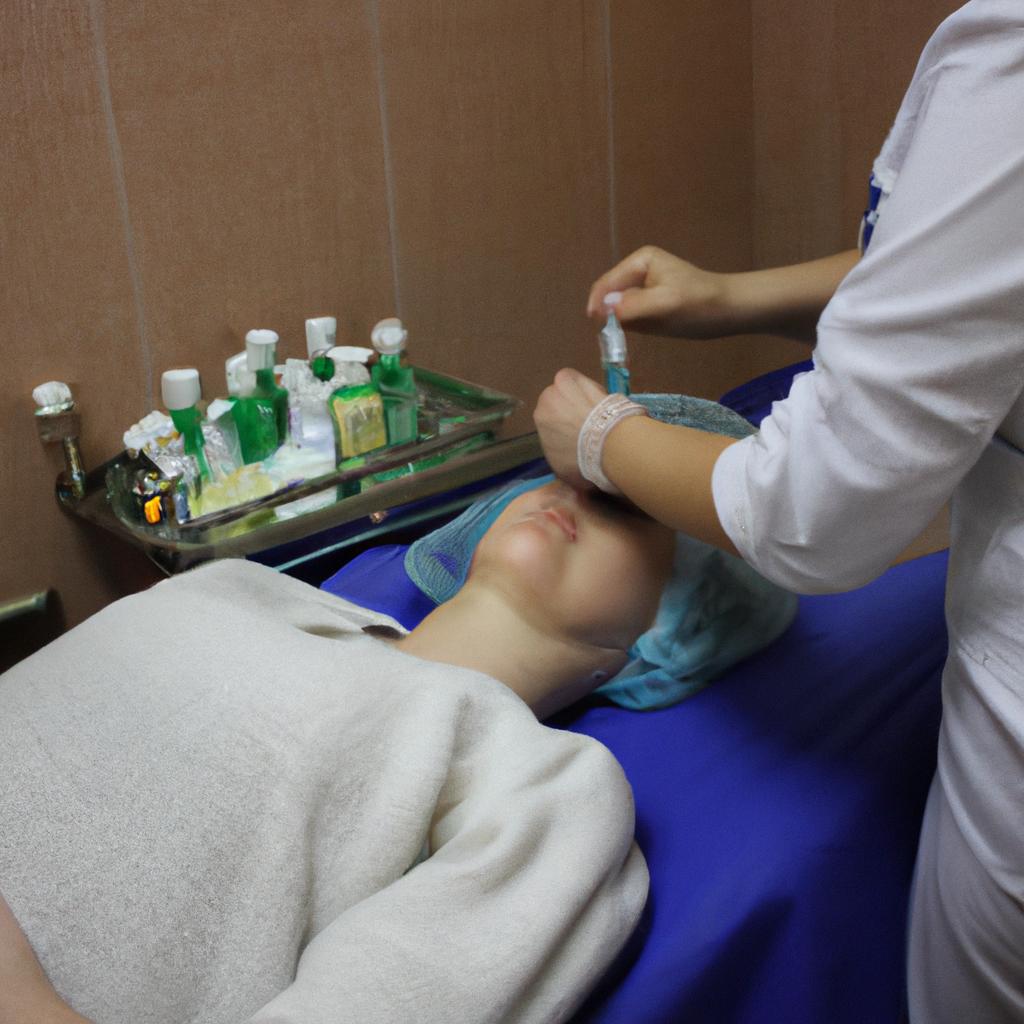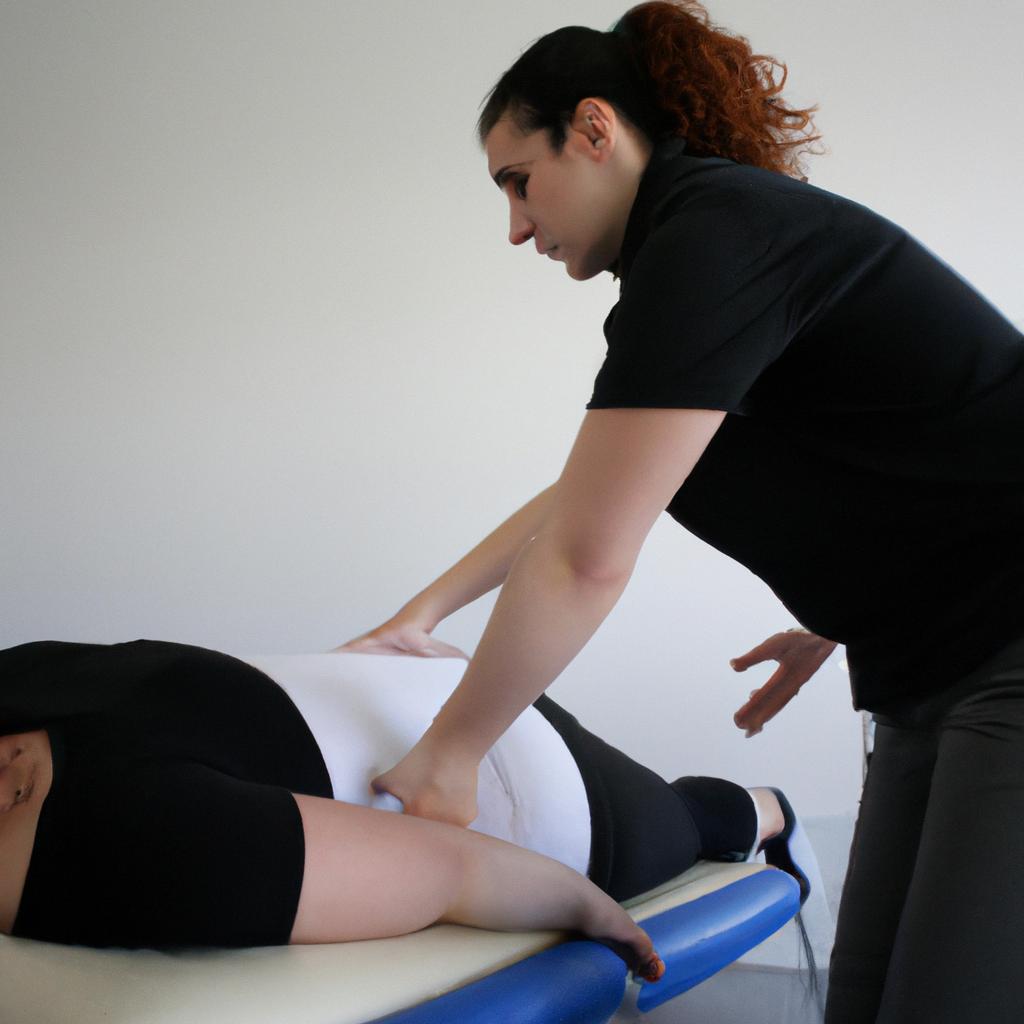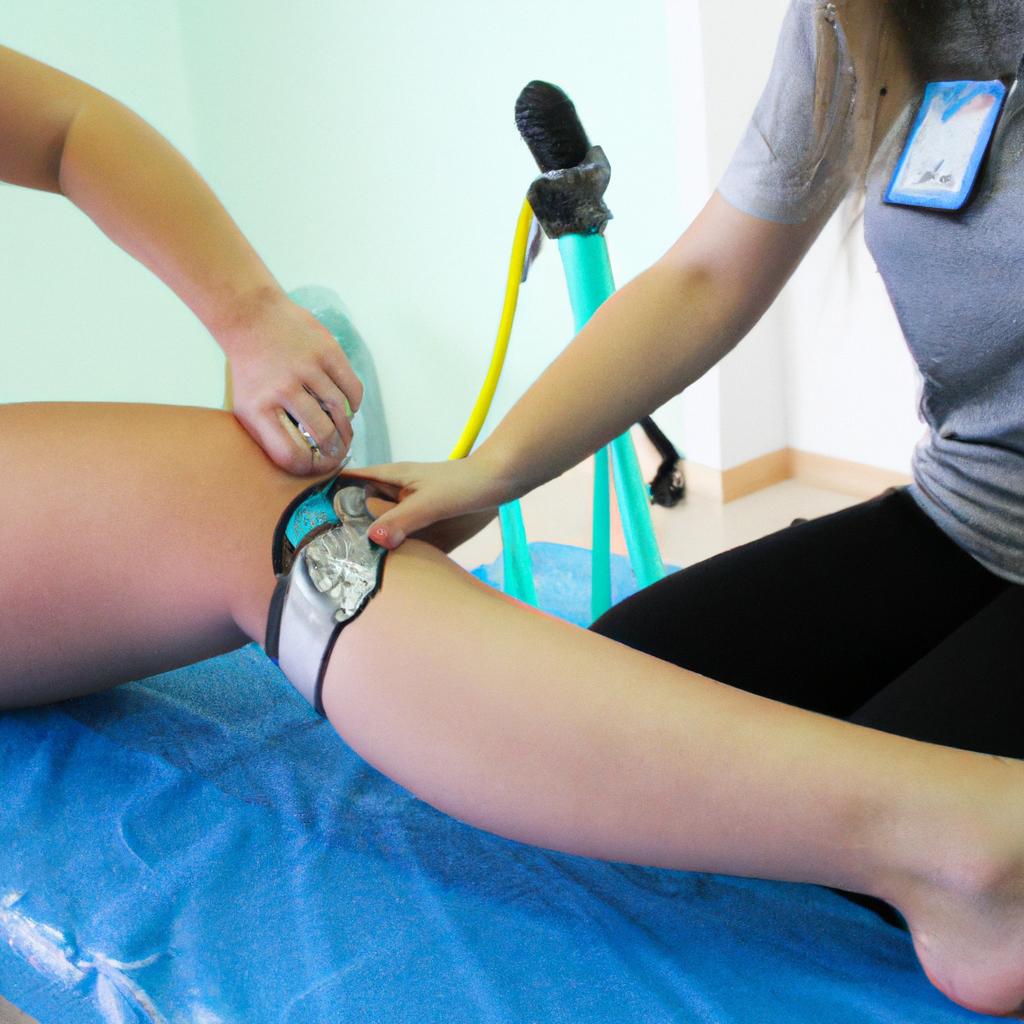Muscle Inflammation in Body Myositis: Inflammatory Myositis

Muscle inflammation, a common condition in the realm of autoimmune diseases, presents itself as an intriguing subject for further investigation. Among the various types of muscle inflammatory disorders, body myositis stands out with its distinctive characteristics and implications. This article aims to explore the pathophysiology and clinical manifestations associated with inflammatory myositis, shedding light on this complex disorder.
Consider a hypothetical scenario where a middle-aged individual named John experiences persistent weakness in his limbs along with gradual difficulties in performing daily activities. Upon seeking medical attention, he is diagnosed with inflammatory myositis – a condition characterized by chronic inflammation of skeletal muscles. Inflammatory myositis encompasses different subtypes including polymyositis (PM), dermatomyositis (DM), and inclusion body myositis (IBM). Each subtype displays unique patterns of muscle involvement, disease progression, and response to treatment. Understanding these nuances becomes crucial for accurate diagnosis and tailored management approaches.
The underlying mechanism behind the development of inflammatory myositis remains multifactorial and complex. Autoimmune responses involving abnormal activation of immune cells within the muscular tissue contribute significantly to the perpetuation of inflammation. As infiltrating immune cells release pro-inflammatory cytokines such as interleukin-1β (IL-1β) and tumor necrosis factor alpha (TNF-α), they promote further recruitment of immune cells and perpetuate the inflammatory cascade. Additionally, autoantibodies targeting specific components of muscle tissue, such as anti-Jo-1 antibodies in PM or anti-Mi-2 antibodies in DM, play a role in disease pathogenesis.
Clinical manifestations of inflammatory myositis can vary depending on the subtype. Common symptoms include muscle weakness, fatigue, difficulty swallowing (dysphagia), and skin rashes in the case of DM. Inflammatory myositis predominantly affects proximal muscles, leading to difficulties in activities such as climbing stairs, getting up from a seated position, or lifting objects overhead. The severity and progression of symptoms can also vary among individuals.
Accurate diagnosis of inflammatory myositis involves a combination of clinical evaluation, laboratory tests, and imaging studies. Blood tests may reveal elevated levels of muscle enzymes like creatine kinase (CK) and aldolase, indicating ongoing muscle damage. Electromyography (EMG) can help assess electrical activity within muscles and differentiate between different types of muscle diseases. Muscle biopsy is often recommended to confirm the presence of inflammation and identify specific histopathological features characteristic of inflammatory myositis subtypes.
Treatment strategies for inflammatory myositis aim to reduce inflammation, alleviate symptoms, preserve muscle function, and prevent long-term complications. Immunosuppressive medications such as corticosteroids are commonly used as first-line therapy to suppress abnormal immune responses. Additional immunosuppressive agents like methotrexate or azathioprine may be prescribed if necessary. Physical therapy plays an integral role in maintaining muscle strength and mobility.
In conclusion, inflammatory myositis represents a complex group of disorders characterized by chronic inflammation of skeletal muscles. Understanding the underlying mechanisms involved in its pathophysiology and recognizing the distinctive clinical manifestations associated with each subtype is essential for accurate diagnosis and tailored treatment approaches. Further research and advancements in therapeutic strategies are needed to improve outcomes for individuals living with inflammatory myositis.
Definition of Body Myositis
Definition of Body Myositis
In the realm of medical conditions affecting muscle health, body myositis stands as a prominent and challenging concern. Characterized by inflammation in skeletal muscles, this condition can lead to significant discomfort and impairment in affected individuals. To better understand body myositis, it is crucial to examine its definition, symptoms, and diagnostic criteria.
To illustrate the impact of body myositis, let us consider an example: John, a 45-year-old avid runner who began experiencing gradual weakness and fatigue in his upper arms and thighs. As these symptoms persisted over time without any signs of improvement, he sought medical attention. After undergoing several tests including blood work and electromyography (EMG), John was diagnosed with body myositis. This case study highlights the distressing nature of this condition and emphasizes the importance of early detection.
Body myositis presents itself through various clinical manifestations such as muscle weakness, tenderness, pain, and difficulty performing routine tasks that require strength or endurance. These symptoms often develop slowly over time but can progress rapidly in some cases. Moreover, patients may also experience extramuscular symptoms like joint pain or skin rash. It is essential for healthcare providers to recognize these indicators promptly to initiate appropriate treatment interventions.
Understanding the diagnostic criteria for body myositis aids in accurate identification among patients exhibiting similar symptoms. The American College of Rheumatology has established specific guidelines which include:
- Symptom duration lasting at least three months
- Muscle biopsy showing evidence of inflammatory infiltrates
- Laboratory findings indicating elevated levels of muscle enzymes
- Electromyogram demonstrating characteristic abnormalities
In summary, body myositis poses considerable challenges due to its detrimental effect on skeletal muscles. With its diverse range of symptoms and specific diagnostic criteria mentioned above, identifying this condition accurately becomes paramount for timely intervention. In the subsequent section about “Causes of Muscle Inflammation in Body Myositis,” we will delve into the underlying factors that contribute to its development and progression.
Causes of Muscle Inflammation in Body Myositis
Muscle inflammation in body myositis, also known as inflammatory myositis, is a complex condition that can significantly impact an individual’s quality of life. To better understand the causes and manifestations of this disorder, it is important to explore its underlying mechanisms.
One example illustrating the effects of muscle inflammation in body myositis involves a middle-aged patient named Sarah. Over time, she noticed progressive weakness in her limbs accompanied by fatigue and difficulty performing daily activities. Upon further examination, it was revealed that Sarah had elevated levels of certain enzymes associated with muscle damage. These findings prompted further investigation into the presence of muscle inflammation commonly seen in individuals diagnosed with body myositis.
The causes of muscle inflammation in body myositis are multifactorial and not yet fully understood. However, research has identified several potential contributing factors:
- Autoimmune response: Inflammatory myositis is believed to be an autoimmune disease, where the immune system mistakenly attacks healthy tissues within the muscles.
- Genetic predisposition: Certain genetic variations have been found to increase the risk of developing body myositis.
- Environmental triggers: Exposure to specific environmental factors such as infections or medications may play a role in triggering or exacerbating muscle inflammation.
- Hormonal imbalances: Some evidence suggests that hormonal imbalances could contribute to the development of body myositis, although more research is needed to establish a definitive link.
To provide a visual representation of these factors, let us consider the following table:
| Factors | Description |
|---|---|
| Autoimmune response | Immune system attacking healthy muscle tissue |
| Genetic predisposition | Increased susceptibility due to genetic variations |
| Environmental triggers | Potential influence from infections or medications |
| Hormonal imbalances | Possible association between hormone levels and muscle inflammation |
It is essential for healthcare professionals and researchers alike to delve deeper into understanding these factors to develop effective treatment strategies that target the root causes of muscle inflammation in body myositis.
Transitioning into the subsequent section about “Symptoms and Diagnosis of Body Myositis,” it is crucial to recognize the importance of early detection and accurate diagnosis. By understanding the manifestations and diagnostic tools available, healthcare providers can offer timely interventions, improving patients’ outcomes and overall well-being.
Symptoms and Diagnosis of Body Myositis
Causes of Muscle Inflammation in Body Myositis
Muscle inflammation in body myositis, also known as inflammatory myositis, can be triggered by various factors. To better understand the underlying causes, let us explore a hypothetical case study involving an individual diagnosed with this condition.
Imagine John, a 45-year-old man who has been experiencing persistent muscle weakness and fatigue for several months. After undergoing a series of medical tests, he is diagnosed with body myositis. This autoimmune disorder leads to chronic muscle inflammation in his legs and arms.
There are several potential triggers for muscle inflammation in body myositis:
- Genetic predisposition: Certain genetic variations may increase the risk of developing body myositis.
- Environmental factors: Exposure to specific environmental toxins or infections could potentially contribute to the development of muscle inflammation.
- Autoimmune response: Inflammatory myositis involves an abnormal immune response where the immune system mistakenly attacks healthy tissues, including muscles.
- Unknown causes: In some cases, the exact cause remains unknown despite extensive research efforts.
Now let’s consider the emotional impact that individuals like John might experience when facing these challenges:
- The uncertainty surrounding the precise cause of their condition can lead to frustration and fear.
- Coping with constant muscle pain and weakness may generate feelings of helplessness and despair.
- Individuals may struggle with adapting to physical limitations caused by muscle inflammation, affecting their daily activities and overall quality of life.
- The lack of definitive answers regarding why certain people develop body myositis while others do not can create a sense of isolation and confusion.
| Subtype | Description |
|---|---|
| Polymyositis | Characterized by symmetric proximal muscle weakness |
| Dermatomyositis | Accompanied by distinctive skin rashes |
| Inclusion Body Myositis | Develops primarily in older individuals |
| Necrotizing Autoimmune Myopathy | Associated with muscle fiber degeneration |
In conclusion, the causes of muscle inflammation in body myositis can be diverse and multifaceted. While genetic predisposition and autoimmune responses play a significant role, environmental factors and unknown triggers may also contribute to this condition. Understanding these underlying causes is crucial for developing effective treatment strategies.
Moving forward, let’s now explore the next section on “Treatment Options for Muscle Inflammation” to shed light on how medical professionals address the challenges posed by inflammatory myositis.
Treatment Options for Muscle Inflammation
Symptoms and Diagnosis of Body Myositis can be debilitating for individuals affected by this condition. However, understanding the treatment options available to manage muscle inflammation is crucial in providing relief and improving quality of life. This section will explore some common treatments used to alleviate symptoms associated with inflammatory myositis.
One example that highlights the effectiveness of treatment options involves a 45-year-old patient diagnosed with body myositis. The individual experienced severe muscle weakness accompanied by persistent pain and fatigue. After consultation with a rheumatologist, a combination therapy was prescribed consisting of corticosteroids, immunosuppressants, physical therapy, and lifestyle modifications.
When it comes to managing muscle inflammation in body myositis, there are several approaches that healthcare professionals may recommend:
- Medications: Corticosteroids such as prednisone are commonly prescribed to reduce inflammation and control symptoms. Immunosuppressant drugs like methotrexate or azathioprine may also be utilized to suppress an overactive immune response.
- Physical Therapy: A structured exercise program designed by a physical therapist can help improve strength, flexibility, and range of motion. These exercises aim to prevent muscle atrophy and maintain functionality.
- Lifestyle Modifications: Making certain adjustments in daily routines can contribute significantly to symptom management. Strategies such as pacing oneself throughout activities, using assistive devices when necessary, prioritizing rest periods, and practicing stress-reducing techniques can greatly enhance overall well-being.
- Supportive Care: Seeking emotional support from family members or joining support groups where individuals share similar experiences can provide comfort and encouragement during challenging times.
To better illustrate these treatment options visually, consider the following table:
| Treatment Options | Description |
|---|---|
| Medications | – Corticosteroids (e.g., prednisone): Reduces inflammation |
| – Immunosuppressants (e.g., methotrexate, azathioprine): Suppresses an overactive immune response | |
| Physical Therapy | – Structured exercise program designed by a physical therapist |
| – Aims to improve strength, flexibility, and range of motion | |
| Lifestyle Modifications | – Pacing activities throughout the day |
| – Using assistive devices when necessary | |
| – Prioritizing rest periods | |
| – Practicing stress-reducing techniques |
In conclusion, managing muscle inflammation in body myositis requires a comprehensive approach that combines medication therapy with physical therapy and lifestyle modifications. The example mentioned earlier serves as a testament to the positive impact these treatments can have on individuals’ lives.
Complications and Prognosis of Body Myositis
Treatment Options for Muscle Inflammation
Muscle inflammation, also known as myositis, is a condition characterized by the inflammation of skeletal muscles. It can be caused by various factors such as autoimmune disorders, infections, or medications. In this section, we will explore the treatment options available to manage muscle inflammation in body myositis.
To illustrate the impact of these treatments, let’s consider a hypothetical case study involving Sarah, a 45-year-old woman diagnosed with inflammatory myositis. Sarah experiences severe muscle weakness and pain, which significantly affects her daily activities. Upon consultation with her rheumatologist, she explores different treatment approaches tailored to her specific needs.
1. Medications: One of the primary treatment modalities for managing muscle inflammation is medication therapy. Corticosteroids are commonly prescribed to reduce inflammation and suppress the immune system response that contributes to muscle damage. Sarah’s doctor prescribes prednisone initially at a high dose and gradually tapers it down over time to find an optimal maintenance dosage.
2. Physical Therapy: Alongside medication therapy, physical therapy plays a vital role in alleviating symptoms and improving overall function in individuals with muscle inflammation. A certified physical therapist designs an exercise program specifically targeting Sarah’s weakened muscles while considering her limitations due to pain and fatigue. Regular physical therapy sessions help restore strength and range of motion in affected muscles.
3. Lifestyle Modifications: Making certain lifestyle modifications can also contribute positively towards managing muscle inflammation. For instance, ensuring adequate rest between activities helps prevent further strain on already inflamed muscles. Additionally, maintaining a healthy diet rich in anti-inflammatory foods like fruits and vegetables may have potential benefits for reducing overall systemic inflammation.
The emotional toll associated with living with muscle inflammation cannot be overlooked either:
- Frustration: Dealing with chronic pain and limited mobility can lead to frustration.
- Anxiety: The uncertainty surrounding disease progression can cause anxiety.
- Isolation: Physical limitations may result in social isolation and feelings of loneliness.
- Depression: The impact on daily life can lead to depression or other mood disorders.
To provide a concise overview, the table below summarizes some key treatment options for muscle inflammation:
| Treatment Options | Description |
|---|---|
| Medications | Corticosteroids are commonly prescribed to reduce inflammation and suppress immune system response. |
| Physical Therapy | Exercise programs designed by physical therapists help restore strength and range of motion in affected muscles. |
| Lifestyle Modifications | Resting between activities and maintaining a healthy diet rich in anti-inflammatory foods contribute towards managing muscle inflammation. |
While these treatment options offer hope for individuals with inflammatory myositis, it is important to note that each case is unique, requiring an individualized approach under the guidance of healthcare professionals.
Transitioning seamlessly into the subsequent section about “Prevention and Management of Muscle Inflammation,” we must understand how to proactively address this condition rather than waiting for symptoms to worsen.
Prevention and Management of Muscle Inflammation
Section: Muscle Inflammation in Body Myositis: Inflammatory Myositis
Complications and poor prognosis often accompany body myositis, a chronic inflammatory disorder of the skeletal muscles. However, understanding the prevention and management strategies for muscle inflammation can significantly improve patients’ quality of life. This section will discuss various approaches to prevent and manage muscle inflammation in individuals with body myositis.
Example Case Study: Consider Sarah, a 45-year-old woman diagnosed with body myositis five years ago. Despite receiving standard treatment, she experiences recurrent episodes of muscle inflammation that greatly affect her daily activities. Understanding the potential complications associated with this condition is crucial in developing effective preventive measures.
To effectively manage muscle inflammation in body myositis, several key points should be considered:
- Medication: Anti-inflammatory medications such as corticosteroids are commonly prescribed to reduce muscle inflammation. These drugs work by suppressing the immune response responsible for attacking healthy muscle tissue.
- Physical Therapy: Regular physical therapy sessions focusing on stretching exercises can help improve flexibility, decrease pain, and maintain joint mobility. Physical therapists also play a vital role in educating patients about proper posture and body mechanics during daily activities.
- Lifestyle Modifications: Adopting a balanced diet rich in anti-inflammatory foods (e.g., fruits, vegetables, whole grains) may help alleviate symptoms of muscle inflammation. Additionally, avoiding triggers like excessive stress and overexertion can minimize the risk of flare-ups.
- Supportive Care: Emotional support from family members or joining support groups where individuals share their experiences living with body myositis can provide reassurance and motivation throughout the journey.
The following table highlights common preventive measures and management strategies employed for reducing muscle inflammation in body myositis:
| Prevention Strategies | Management Approaches |
|---|---|
| Adhering to medication regimen | Regular monitoring of disease progression |
| Practicing stress-reducing techniques | Collaborative care involving healthcare professionals |
| Maintaining a healthy lifestyle | Utilizing assistive devices to conserve energy and minimize muscle strain |
| Participating in regular physical activity within individual capabilities | Incorporating adaptive aids for daily activities |
In conclusion, the prevention and management of muscle inflammation in body myositis require a comprehensive approach that includes medication, physical therapy, lifestyle modifications, and supportive care. By implementing these strategies effectively, individuals with body myositis can better control their symptoms and improve their overall well-being.
Note: The information provided here is for educational purposes only and should not replace professional medical advice. Please consult your healthcare provider for personalized guidance.


